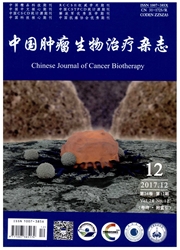

 中文摘要:
中文摘要:
目的:研究利用聚酰胺(polyamidoamine,PAMAM)树形分子递送survivin基因反义寡核苷酸(antisense oligodeoxy—nucleotide,asODN)抑制人肝癌细胞株HepG2细胞增殖的效应。方法:采用第1至第5代的聚酰胺树形分子室温下与反义survivin寡核苷酸混合制备树形分子与反义寡核苷酸的复合物(PAMAM—asODN),应用琼脂糖凝胶电泳及原子力学显微镜观察复合物的形态结构。PAMAM—asODN复合物转染HepG2细胞,同时设survivin反义寡核苷酸转染细胞作对照。共聚焦荧光显微镜检测复合物细胞转染效果;RT—PCR分析转染后细胞survivin mRNA的表达水平;MTT法检测复合物对HepG2细胞增殖的抑制效应。结果:琼脂糖凝胶电泳分析表明,树形分子与survivin反义寡核苷酸具有高效络合作用,形成了大小为25nm左右的复合物;共聚焦荧光显微镜检测显示,与对照相比,PAMAM-asODN复合物转染细胞的效率显著提高;RT—PCR的结果表明,转染PAMAM-asODN复合物的肿瘤细胞中survivin mRNA表达显著降低;MTT结果表明,树形分子递送survivin反义寡核苷酸进入细胞后,HepG2细胞增殖明显受抑制,增殖抑制率随培养时间、复合物浓度、树形分子代数的增加而增加,6.0μmol/LG4.0 PAMAM—asODN与细胞培养96h可使抑制率达55%以上。结论:PAMAM树形分子能高效递送survivin asODN进入细胞,并抑制HepG2肿瘤细胞的增殖。树形分子可能是一种高效基因药物递送载体,在肿瘤治疗中具有潜在应用价值。
 英文摘要:
英文摘要:
Objective: To use polyamidoamine (PAMAM) dendrimer as gene delivery system for survivin gene antisense oligodeoxynucleotide (asODN) transfection for inhibition of HepG2 cancer cell growth. Methods: The first to the fifth generation of PAMAM and asODN were used to prepare a complex: PAMAM-asODN. The morphology of PAMAM- asODN was observed using agrose electrophoresis and atomic force microscope (AFM). PAMAM-asODN was then used to transfect HepG2 cells and cells transfected with asODN served as control. The transfection efficacy of PAMAM-asODN into HepG2 cells was observed under confocol microscope, the surviving mRNA expression was analyzed by RT-PCR, and the inhibition of HepG2 cell growth was determined by MTT assay. Results: Agrose electrophoresis showed strong complexing action between PAMAM and asODN and they formed a complex with a diameter of 25 nm. Confocol microscope showed the transfection efficacy of PAMAM-asODN was higher than that of asODN. RT-PCR showed a decreased expression of survivin mRNA in PAMAM-asODN transfected cells. MTT results demonstrated that the growth of HepG2 cell was obviously inhibited after transfection of PAMAM-asODN and the inhibition rate increased with culture time, concentration of complex, the generation of PAMAM. PAMAM-asODN at 6.0 μmoL/L G4.0 resulted in a 55% inhibition of HepG2 cells 96 h after culture. Conclusion: PAMAM dendrimers can efficiently mediate the entry of survivin asODN into HepG2 cells, resuiting in inhibition of HepG2 cells. PAMAM might be a promising gene carrier for potential molecular therapy of cancer.
 同期刊论文项目
同期刊论文项目
 同项目期刊论文
同项目期刊论文
 期刊信息
期刊信息
